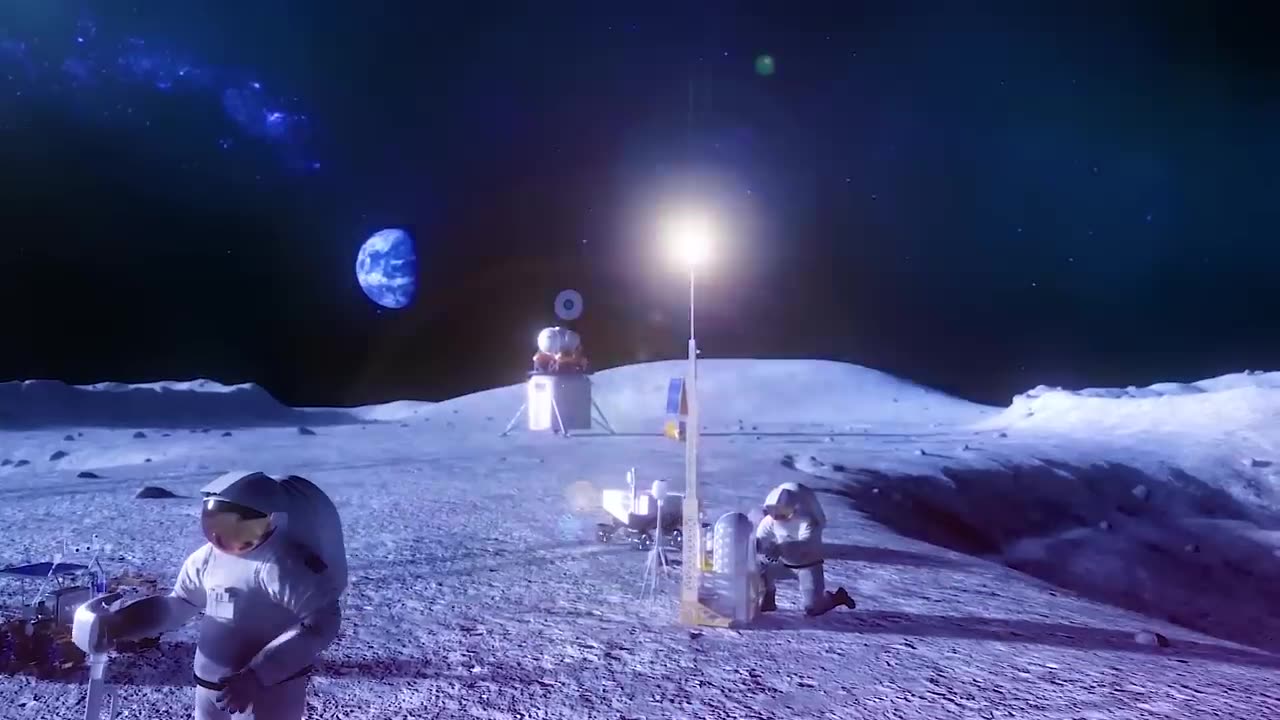Premium Only Content

How Will We Extract Water on the Moon?
Extracting water on the Moon is a crucial aspect of future lunar exploration and potential habitation. Water is valuable for several reasons: it can provide drinking water for astronauts, serve as a source of oxygen through electrolysis, and be used for generating rocket propellant (hydrogen and oxygen) for deep space missions. There are a few methods being considered for extracting water on the Moon:
Lunar Polar Ice: One of the primary sources of water on the Moon is believed to be in the form of ice located at its polar regions. These areas receive very little sunlight, and some craters are in perpetual shadow, allowing water ice to accumulate over billions of years. Extracting this ice involves sending robotic or manned missions to these regions, where specialized equipment could dig, drill, or scrape the surface to gather ice. This ice could then be heated to release water vapor, which could be condensed and collected.
Permafrost Mining: Water molecules are also believed to be embedded in the lunar soil, known as regolith, even in areas where ice isn't directly visible. Mining and processing the regolith to release water molecules is another potential method. This could involve heating the regolith to release water vapor, and then collecting and condensing the vapor.
Solar Hydrogen Production: In this method, solar panels would be used to generate electricity, which could then power an electrolysis process to separate water molecules (H2O) into hydrogen (H2) and oxygen (O2). This is a feasible method for extracting oxygen for breathing and for creating hydrogen for rocket fuel.
Microwave Extraction: Another proposed technique involves using microwaves to heat the lunar regolith. The heat generated would release water vapor from the regolith, which could then be collected and condensed.
Hydrogen Reduction: This method involves using hydrogen as a reducing agent to chemically break down minerals in the regolith that contain bound water. This could release water vapor that can be collected and processed.
Mining Lunar Caves: Some scientists suggest that natural cavities or caves on the Moon could contain ice deposits. These caves could provide an environment where water ice is protected from the harsh lunar surface conditions. Robots or astronauts could explore these caves and extract water if ice is found.
The challenges in extracting water on the Moon include the harsh environment (extreme temperatures, vacuum, and radiation), the need for energy sources, and the development of reliable and efficient extraction technologies. Robotic missions are expected to pave the way for human missions by testing and refining these techniques. As our understanding of lunar water resources grows and technology advances, we'll likely see a combination of these methods being used to extract water and utilize it for various purposes on the Moon.
#NASA: The official hashtag for NASA, covering a wide range of topics related to space exploration, research, and discoveries.
#SpaceExploration: Used for discussions and updates on various space missions and exploration activities.
#MoonMission: Relevant to missions and discussions related to lunar exploration and research.
#MarsMission: Used to follow updates and news about missions to Mars, including the Perseverance rover and other Mars-related projects.
#InternationalSpaceStation: Focused on content related to the ISS, crew activities, and research conducted on the space station.
#Astronomy: For content related to observations, discoveries, and news in the field of astronomy.
#Astrophysics: Used for discussions and updates related to the study of the physical properties and nature of the universe.
#SpaceScience: Covers various scientific aspects of space, including planetary science, astrophysics, and more.
#RocketLaunch: Relevant to posts about rocket launches, whether by NASA or other space agencies.
#HubbleSpaceTelescope: For content related to the Hubble Space Telescope, its observations, and discoveries.
#SpaceTechnology: Covers advancements and innovations in space-related technologies.
#Exoplanets: Used for content related to the discovery and study of exoplanets (planets outside our solar system).
#SpaceDiscovery: Highlights new discoveries and breakthroughs in the field of space science.
#STEM: Relevant for posts related to science, technology, engineering, and mathematics education and careers.
#Astrobiology: For discussions about the search for life beyond Earth and the study of potential extraterrestrial life.
Remember that the popularity and relevance of hashtags can change over time, so it's a good idea to explore social media platforms to see which hashtags are currently trending and widely used for NASA-related content.
-
 LIVE
LIVE
Akademiks
5 hours agoDiddy is RUNNING The Jail! Feds Fear He's Unstoppable even behind Bars! Drake Revenge Era?
6,120 watching -
 LIVE
LIVE
Fed Reacts
4 hours agoZODIAC KILLER PT 2
3,469 watching -
 2:12:41
2:12:41
TheSaltyCracker
7 hours agoMSM Implodes After Trump Win ReeEEeE Stream 11-17-24
169K357 -
 4:31
4:31
SLS - Street League Skateboarding
10 days agoFuna Nakayama 3rd Place at SLS Sydney 2024 | Best Tricks
50.7K6 -
 2:15:24
2:15:24
vivafrei
15 hours agoEp. 236: BARNES IS BACK! Election Recap! Trump Nominees! Trump Persecutions - Wha's Next? & MORE!
198K194 -
 6:25:47
6:25:47
SynthTrax & DJ Cheezus Livestreams
14 hours agoDJ Cheezus & DEF JAM Fight for NY on PS2 - Hip Hop Violence and Vibes (1pm PST / 4pm EST)
64K4 -
 2:01:47
2:01:47
Nerdrotic
10 hours ago $12.68 earnedEgypt, Peru and Guatemala Luke Caverns RETURNS! | Forbidden Frontier #082
67.7K9 -
 LIVE
LIVE
Vigilant News Network
10 hours agoFDA Approves Trials for New “Pandemic” Vaccine | Media Blackout
3,672 watching -
 4:06:21
4:06:21
GamerGril
10 hours agoIM THE GREASTEST OF ALL TIME AT.... CHAOS | DAYS GONE
111K12 -
 3:00:18
3:00:18
Due Dissidence
1 day agoTHE PEOPLE VS NATURE by Kevin Augustine - plus a talkback w/ Jimmy Dore
126K11